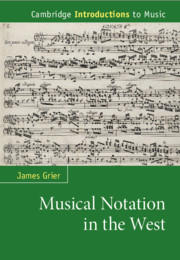Book contents
- Musical Notation in the West
- Musical Notation in the West
- Copyright page
- Dedication
- Contents
- Figures
- Tables
- Musical Examples
- Preface
- Chapter 1 Introduction: Musical Notation as a Symbolic Language
- Chapter 2 Plainsong and the Origins of Musical Notation in the West
- Interlude 1: The Problem with Pitch
- Chapter 3 Polyphony and Rhythmic Notation
- Interlude 2: Rhythm and Metre
- Chapter 4 The Transition to the Modern Era: Instrumental Music and Performing Indications
- Interlude 3: The Score
- Chapter 5 Notational Nuance in the Twentieth Century and the Motives for Notational Innovation
- Coda: The Meaning of Musical Literacy
- Bibliography
- Index
- Cambridge Introductions to Music
Chapter 1 - Introduction: Musical Notation as a Symbolic Language
Published online by Cambridge University Press: 28 January 2021
- Musical Notation in the West
- Musical Notation in the West
- Copyright page
- Dedication
- Contents
- Figures
- Tables
- Musical Examples
- Preface
- Chapter 1 Introduction: Musical Notation as a Symbolic Language
- Chapter 2 Plainsong and the Origins of Musical Notation in the West
- Interlude 1: The Problem with Pitch
- Chapter 3 Polyphony and Rhythmic Notation
- Interlude 2: Rhythm and Metre
- Chapter 4 The Transition to the Modern Era: Instrumental Music and Performing Indications
- Interlude 3: The Score
- Chapter 5 Notational Nuance in the Twentieth Century and the Motives for Notational Innovation
- Coda: The Meaning of Musical Literacy
- Bibliography
- Index
- Cambridge Introductions to Music
Summary
By the early twenty-first century, Western musical notation has developed into an extraordinarily rich and complex piece of visual communication. Modern musicians expend considerable time and energy to create strategies for its more efficient comprehension. Simultaneously, musicians are continuously inventing new symbols and systems of symbols for two very different reasons. Some wish to communicate with ever greater precision the instructions necessary for the reproduction of a musical work. Others are seeking ways of recording in writing musics whose origins are not necessarily rooted in notation. Charles Seeger identified these two streams as, respectively, “prescriptive” and “descriptive” forms of notation.
- Type
- Chapter
- Information
- Musical Notation in the West , pp. 1 - 7Publisher: Cambridge University PressPrint publication year: 2021

